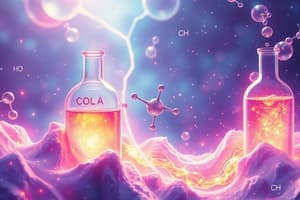Podcast
Questions and Answers
Which of the following has the greatest number of atoms? a. 26.98 g of Al b. 1 mole of S c. 5 moles of O2 d. 18.02 g H2O e. All are the same
Which of the following has the greatest number of atoms? a. 26.98 g of Al b. 1 mole of S c. 5 moles of O2 d. 18.02 g H2O e. All are the same
- 26.98 g of Al
- 5 moles of O2 (correct)
- 1 mole of S
- 18.02 g H2O
- All are the same
Calculate the molar mass of manganese (IV) oxalate.
Calculate the molar mass of manganese (IV) oxalate.
206.11 g/mol
How many moles are in 53.0 g of CH4?
How many moles are in 53.0 g of CH4?
3.30 moles
What is the mass of 6.9x10^25 molecules of NO?
What is the mass of 6.9x10^25 molecules of NO?
Which of the following iron compounds contains the greatest percentage of iron: pyrite (FeS2), hematite (Fe2O3), or siderite (FeCO3)?
Which of the following iron compounds contains the greatest percentage of iron: pyrite (FeS2), hematite (Fe2O3), or siderite (FeCO3)?
Determine the percent composition of Ca(NO3)2.
Determine the percent composition of Ca(NO3)2.
A fluoride of aluminum is 67.87% F. What is the formula of this compound?
A fluoride of aluminum is 67.87% F. What is the formula of this compound?
The empirical formula of C2H5OH is __________.
The empirical formula of C2H5OH is __________.
The empirical formula of C6H12O6 is __________.
The empirical formula of C6H12O6 is __________.
What is the empirical formula for a compound that is 40.00% C, 6.713% H and 53.28% O by mass?
What is the empirical formula for a compound that is 40.00% C, 6.713% H and 53.28% O by mass?
If the molecular mass of a compound is 60.052 g, what is its molecular formula if the empirical formula is C3H6O?
If the molecular mass of a compound is 60.052 g, what is its molecular formula if the empirical formula is C3H6O?
What is the limiting reactant if 14.0 g N2 is mixed with 9.0 g H2?
What is the limiting reactant if 14.0 g N2 is mixed with 9.0 g H2?
How much excess reactant is left over after the reaction?
How much excess reactant is left over after the reaction?
What is the theoretical yield of NH3?
What is the theoretical yield of NH3?
What is the percent yield if 16.1 g of NH3 actually forms?
What is the percent yield if 16.1 g of NH3 actually forms?
What is collision theory?
What is collision theory?
What are the requirements for a successful collision?
What are the requirements for a successful collision?
How would increasing the temperature affect the rate of a reaction?
How would increasing the temperature affect the rate of a reaction?
At equilibrium, the amount of products must equal the amount of reactants.
At equilibrium, the amount of products must equal the amount of reactants.
During equilibrium, the concentration of the products does not change.
During equilibrium, the concentration of the products does not change.
A collision between reactants is all that is needed to cause a reaction.
A collision between reactants is all that is needed to cause a reaction.
If K > 1, __________ are favored.
If K > 1, __________ are favored.
If K < 1, ______________ are favored.
If K < 1, ______________ are favored.
What are the definitions for acids & bases?
What are the definitions for acids & bases?
What is meant by the term amphiprotic?
What is meant by the term amphiprotic?
What is specific heat capacity?
What is specific heat capacity?
Calculate the pH of a solution with [H+] = 0.00100 M.
Calculate the pH of a solution with [H+] = 0.00100 M.
What is an indicator and what is it used for?
What is an indicator and what is it used for?
Flashcards
Mole concept
Mole concept
A mole is a quantity of a substance containing 6.022 x 10^23 particles (atoms, molecules, or ions).
Molar mass
Molar mass
The mass of one mole of a substance in grams.
Percent composition
Percent composition
The percentage by mass of each element in a compound.
Empirical formula
Empirical formula
Signup and view all the flashcards
Molecular formula
Molecular formula
Signup and view all the flashcards
Chemical equation
Chemical equation
Signup and view all the flashcards
Balancing equations
Balancing equations
Signup and view all the flashcards
Stoichiometry
Stoichiometry
Signup and view all the flashcards
Limiting reactant
Limiting reactant
Signup and view all the flashcards
Excess reactant
Excess reactant
Signup and view all the flashcards
Theoretical yield
Theoretical yield
Signup and view all the flashcards
Percent yield
Percent yield
Signup and view all the flashcards
Saturated solution
Saturated solution
Signup and view all the flashcards
Unsaturated solution
Unsaturated solution
Signup and view all the flashcards
Solubility
Solubility
Signup and view all the flashcards
Net ionic equation
Net ionic equation
Signup and view all the flashcards
Molarity
Molarity
Signup and view all the flashcards
Equilibrium
Equilibrium
Signup and view all the flashcards
Equilibrium constant (K)
Equilibrium constant (K)
Signup and view all the flashcards
Le Chatelier's principle
Le Chatelier's principle
Signup and view all the flashcards
Arrhenius acid
Arrhenius acid
Signup and view all the flashcards
Bronsted-Lowry acid
Bronsted-Lowry acid
Signup and view all the flashcards
Exothermic reaction
Exothermic reaction
Signup and view all the flashcards
Endothermic reaction
Endothermic reaction
Signup and view all the flashcards
Specific heat capacity
Specific heat capacity
Signup and view all the flashcards
Calorimetry
Calorimetry
Signup and view all the flashcards
Study Notes
Unit 7 – The Mole
- Understand the mole concept for estimating quantities in reactions.
- Calculate molar mass from chemical formulas and names.
- Convert between particles, mass, and volume in chemical calculations.
- Determine percent composition for compounds based on element mass.
- Identify empirical and molecular formulas from composition data.
Unit 8 – Balancing Equations and Stoichiometry
- Recognize types of chemical reactions.
- Balance chemical equations using stoichiometric coefficients.
- Derive chemical equations from word problems.
- Use balanced equations for reactant/product ratios.
- Convert between grams, particles, and liters during reactions.
- Identify the limiting reactant and calculate excess reactant and theoretical yield.
- Determine percent yield based on actual and theoretical yield.
Unit 9 – Reactions and Solutions
- Differentiate between saturated, unsaturated, and supersaturated solutions.
- Explain solubility concepts at both macroscopic and particle levels.
- Use solubility rules to assess the solubility of ionic compounds.
- Write solvation equations showing the dissociation of soluble ionic compounds.
- Construct and interpret molecular, complete ionic, and net ionic equations.
- Solve concentration problems using molarity and dilution equations.
Unit 10 – Equilibrium
- Identify factors affecting reaction rates.
- Explain how equilibrium is achieved in reversible reactions.
- Write equilibrium constant expressions and calculate K values from reactions.
- Analyze reaction extent through K value magnitudes.
- Apply ICE tables for calculating equilibrium concentrations.
- Utilize LeChatelier’s principle for predicting shifts in equilibrium.
Unit 11 – Acids and Bases
- Define acids and bases using Arrhenius and Bronsted-Lowry theories.
- Identify conjugate acid-base pairs in reactions.
- Recognize key physical and chemical properties of acids and bases.
- Calculate H⁺ and OH⁻ concentrations using Kw relationships.
- Describe and compute pH values for acidic and basic solutions.
- Explain acid-base reactions, including titrations and stoichiometric calculations.
Unit 12 – Thermochemistry
- Distinguish between exothermic and endothermic reactions based on enthalpy.
- Draw energy diagrams highlighting ΔH and activation energy.
- Understand the impact of specific heat capacity on thermal properties.
- Perform calculations with the specific heat formula.
- Use calorimetry to determine energy changes in reactions and apply Hess’s Law for ΔH calculations.
Important Concepts and Example Calculations
- Molar mass of compounds, percentage composition calculations.
- Limiting reactant identification in stoichiometric equations.
- Equilibrium constant calculations and Q comparisons to predict shifts.
- Capitalize on the relationship between pH, [H⁺], and [OH⁻] in aqueous solutions.
- Use reaction enthalpy to calculate energy changes in chemical processes.
Noteworthy Questions
- Key problem-solving questions regarding mole conversions, balancing equations, and equilibrium states.
- Practical applications of acid-base neutralization, as well as calorimetry for energy calculations.
- Significant equations for solubility predictions, including molecular forms and precipitation reactions.
Tips for Exam Preparation
- Practice calculations involving molar mass and concentration.
- Engage in problems that require balancing equations and deriving net ionic equations.
- Familiarize with equilibrium concepts and the significance of K and Q values.
- Utilize sample acidic and basic titration problems for proficiency in pH calculations.
Studying That Suits You
Use AI to generate personalized quizzes and flashcards to suit your learning preferences.





